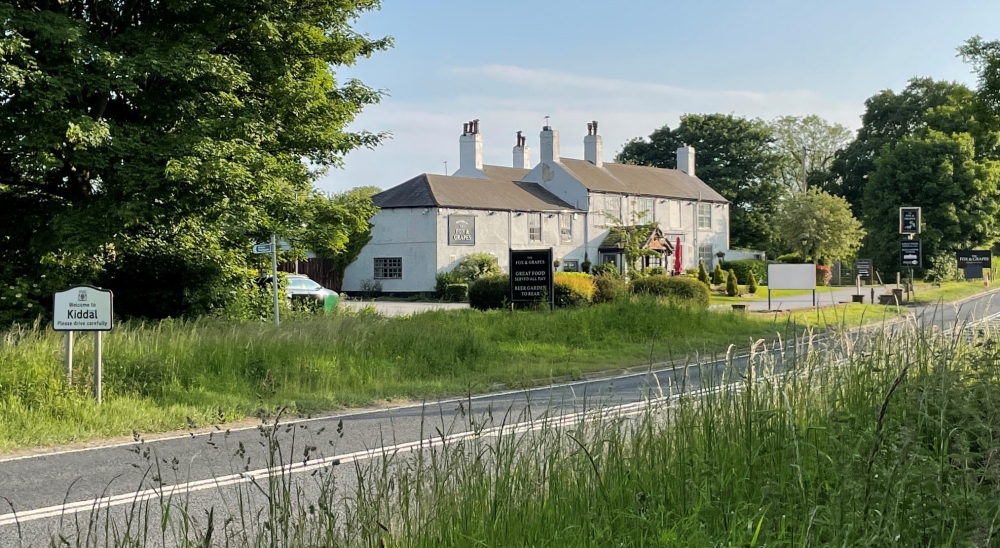|
So wrote John Taylor, known as the water poet, of his visit to a forerunner of the Fox & Grapes Public House in Kiddal. Even 400 years ago the road at Kiddal must have been an important east/west route and in 1751 it was turnpiked. An Act of Parliament was passed for "..repairing the Road from Tadcaster in the West Riding of Yorkshire, over Bramham Moor through Kidhall Lane, over Win Moor, and through Seacroft to a Place called Halton Dyal, where it comes into the road between Selby and Leeds.." The act continued "..and great part of the road between Tadcaster and Halton Dyal, from the narrowness thereof in several places, and from the nature of the soil, in some seasons of the year, impassable for wheel-carriages, and dangerous for travellers.." The act allowed tolls to be charged and the money used to purchase land to widen, straighten and maintain the road. Toll houses with gates were installed along the route to ensure that money was collected. The charges authorised were: - Waggon with coal drawn by 6 horses. - 1 shilling (no coal 2 shillings) - Waggon with coal drawn by 5 horses. - 6 pence (no coal 1 shilling 6 pence) - Waggon with coal drawn by 4 horses. - 4 pence (no coal 1 shilling) - Waggon with coal drawn by 3 horses. - 3 pence (no coal 9 pence) - Waggon with coal drawn by 2 horses. - 2 pence (no coal 4 pence) - Coach drawn by 6 horses. - 1 shilling & 6 pence - Coach drawn by 4 horses. - 1 shilling - Coach drawn by 2 horses. - 6 pence - Chair drawn by 1 horse. - 3 pence - 1 horse. - 1 penny - Drove of cattle (per score). - 10 pence - Drove of calves, swine, sheep or lambs (per score).- 5 pence 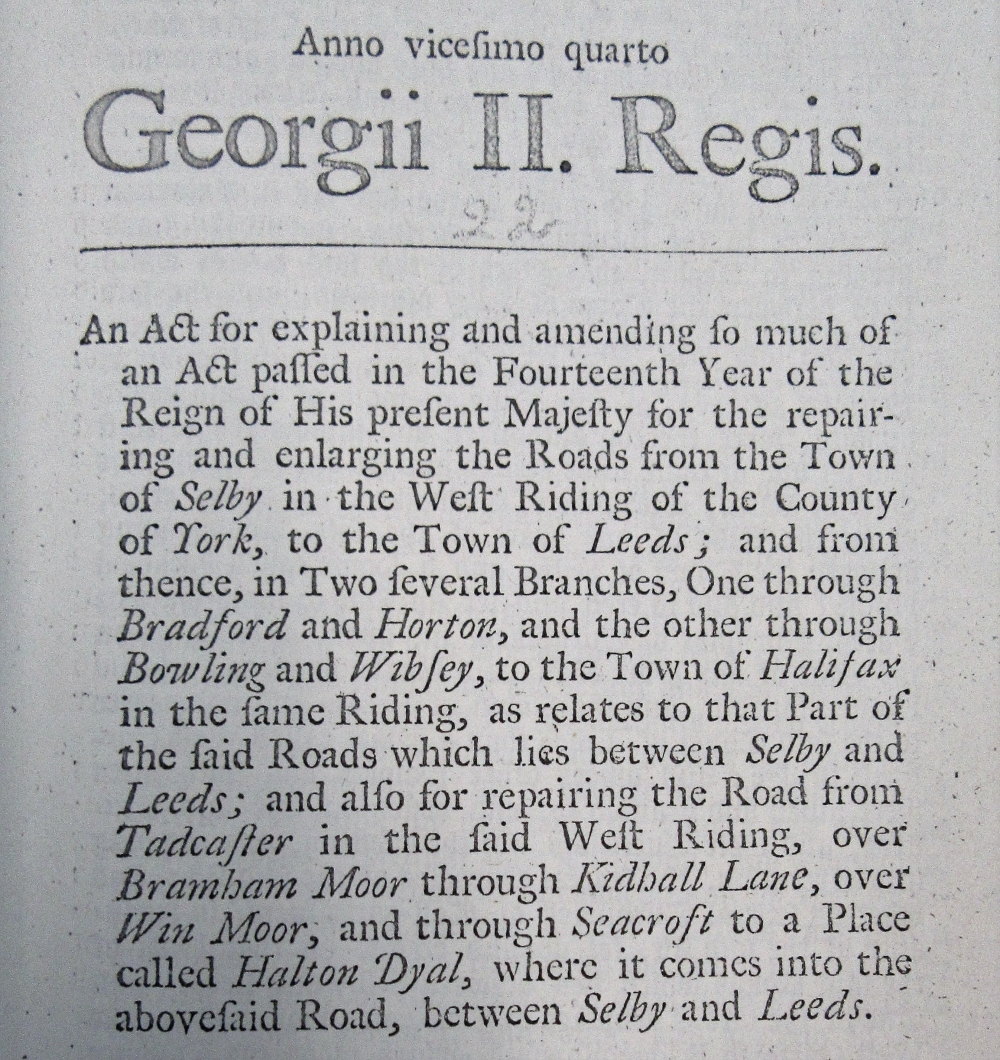 1750 Act of Parliament for Turnpike Road. At some stage a toll house and gate was installed at Kiddal Lane End, an important crossing point with roads to Thorner, Bramham and Barwick and to pick up traffic heading from and to the Great North Road (now the A1(M)). No doubt this will have made the small hamlet a hive of activity at times and trade increase at the ancient inn nearby. The road at this time was very winding with a sharp turn in front of the inn and also at Bar House Farm. It also ran past the side of Kiddal Hall. Around 1823 the Turnpike Trust removed most of the bends and widened much of the road. The early history of the inn is lost with just occasional snippets of information. In the 1730s Thomas Haist was running an Inn at Kiddal. In April 1768 a man staying at an inn, then known by the Sign of the Blue Boar, Kid Hall Lane died suddenly, he was buried at nearby Barwick, only known by the name "Michel" he was foreign and had recently been working as a translator in York. Things start to become clear in the 1770s and in 1775 William Carr and his wife Alice were running an inn at Kiddal and by August 1786 we have the 1st reference to the name, with an advertisement of a meeting to discuss enclosing the open fields of the Parish of Barwick-in-Elmet and that interested parties meet "at the House of William Carr known by the Sign of the Fox, at Kiddall-Lane-End". 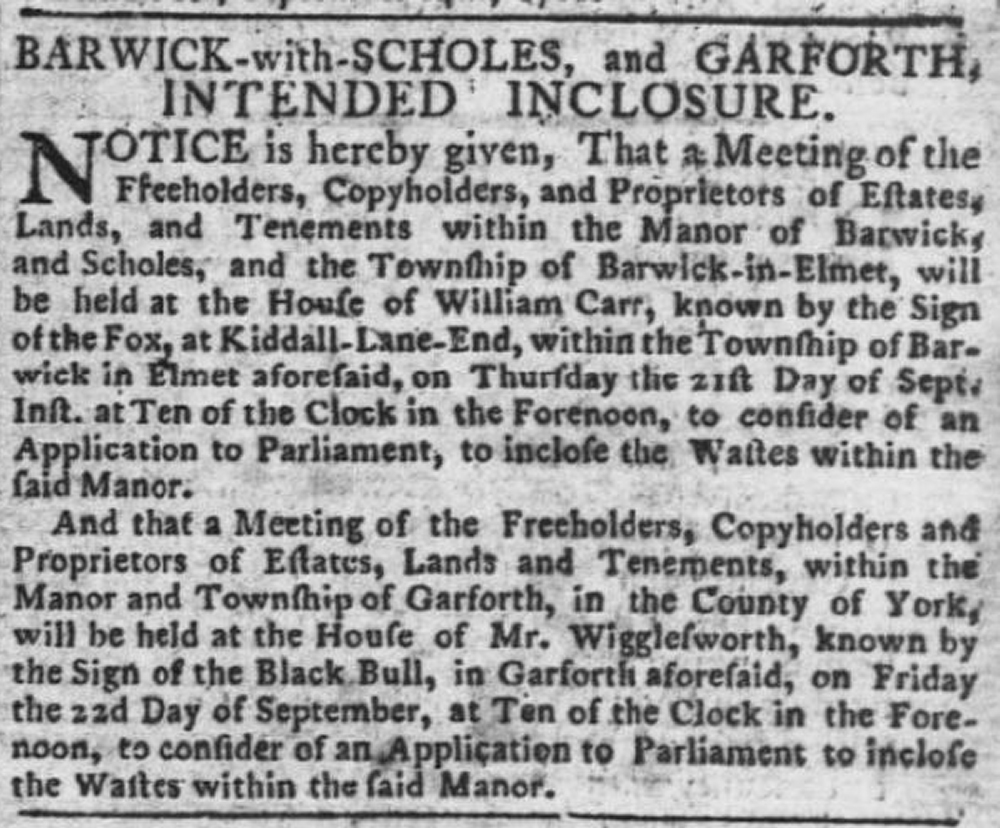 Leeds Intelligencer 19th September 1786 - Sign of the Fox. From 1731 to 1776 ownership of site where the Inn currently stands (and where most likely any old inn was located) was in the hands of George FOX and his wife Harriet and the name of the inn reflects this. Harriet had inherited the property from her father Lord Robert Benson (Lord Bingley) who built Bramham Park. Following Harriet's death in 1771, without children, the property passed in 1776 by the terms of her father's will to Mary Goodricke, her illegitimate half-sister. (See the appendix for the known details of the ownership of the site before 1794) The main trade of the Carr's was farmers, with the Inn as a side business and in a rather bizarre story in September 1787 newspapers throughout the land reported that "A few days ago the amazing number of 226 potatoes, the produce of one single set were taken out of a field belonging to Mr. Carr in Kiddall-Lane." William Carr was paid 12 shillings and 4 pence by the Potterton Surveyor of the Highways in 1792 to provide "ale" for men working on repairing the local roads, similar figures are also listed for the subsequent two decades. In 1793 the inn and adjacent land was owned by Sir Henry Goodricke, he had inherited it from his grandmother, Mary Goodricke. On the 25th June 1793 he sold it to Edward Wilkinson, Esquire, of Potterton Lodge, when it was described as "one newly built messuage (a house with outbuildings and land) with a barn, stables and outbuildings belonging, formerly a cottage with a toft and a croft, previously in the possession of William Knapton but now William Carr." The William Knapton mentioned would have been long since dead as he is mentioned in a deed for same land in 1720. Whether any of the older building survives within the current premises is unknown but it is likely the oldest part of the Inn dates from this period. At some-time between 1790 and the 1820s a large stable block was constructed at a right-angle to the current buildings, on the north/south alignment. This would allow travellers to stay whilst their horses rested and may also have provided stabling for teams of horses for the many stagecoaches which used the route and required frequent changes of horses. It is known that the Carr's employed an ostler (a man employed to look after the horses of people staying at an Inn). The stable block was demolished in 1955. 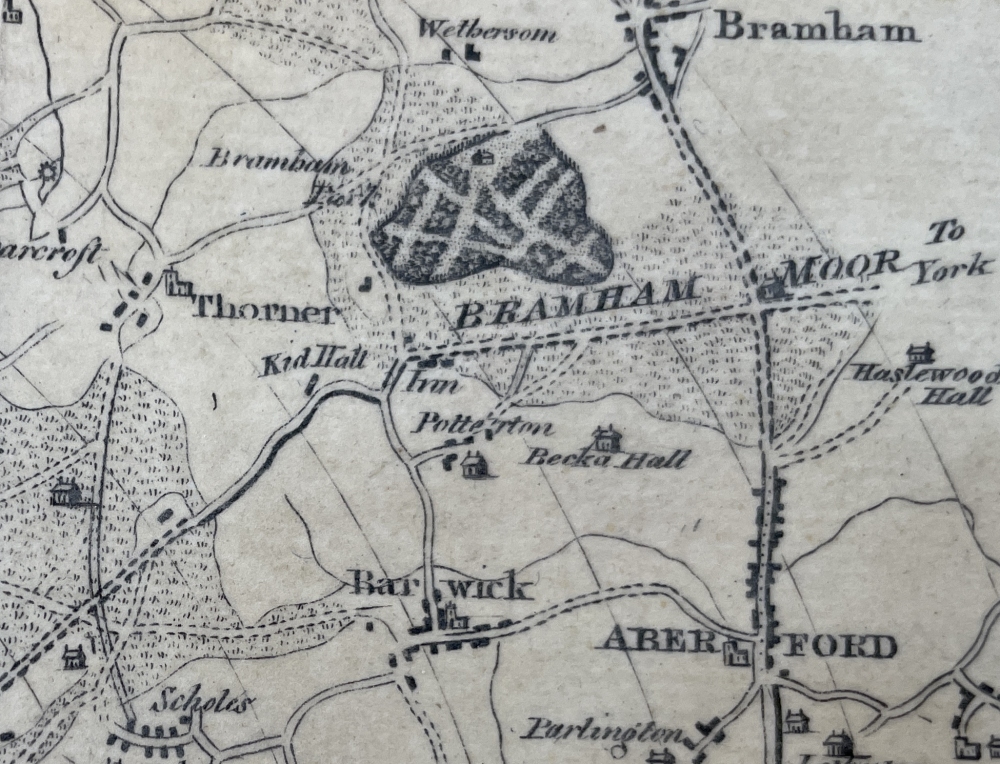 Binns 1800 map of the area showing the Inn before York Road was straightened. William Carr died in 1801 aged 69 and a Thomas Carr took over running the Inn and farm, he had married Elizabth Parfect at Leeds Parish Church a few months before and in 1805 they had a son, Thomas. By 1803, known as the Fox Inn, still owned by Edward Wilkinson, it comprised the Inn, farmhouse and outbuildings with 30 acres 4 perches of land, the tenant Thomas Carr. In August 1807 we find the 1st reference to the modern name when the Leeds Intelligencer newspaper reported that "..on Wednesday 23rd September next, at the Fox and Grapes, at Kiddal-Lane.." an auction sale will take place of land on Whinmoor and Rake-Hill. It maybe the Grapes was added after the Fox family gave up ownership in 1776 to distinguish it from other local Inns with the same name. It also relates to the famous Aesop fable "The Fox and the Grapes." Thomas Carr died suddenly on the 1st December 1808 and his widow, Elizabeth continued to run the Inn. One of the treasures of the Barwick Historical Societies Archives is the Potterton Estate Book which covers part of the 1820s. It lists all the lands owned by the Wilkinson family of Potterton Hall. In it Mrs. Carr is listed as the tenant at the Kiddal Inn and Farm now consisting of 45 acres 3 roods 19 perches of land, her agreement with Mr. Wilkinson was: - Rent clear £80 per Annum and £4 for Morgan Close whilst she continues it, but to give it up whenever Mr. Wilkinson wishes. - To pay all Taxes etc £1 14s 3d for Insurances of Premises which Premium Mr. W. pays to the Agent at Leeds and is repaid by Mrs. Carr in July each year. - To do two days work with one cart and three horses for Mr. Wilkinson in each year. - To quit the Inn and Offices, etc at three months notice at any time and the Land on the 5th day of April next following such 3 months notice. - Grass Land not to be ploughed out into tillage. - Not to take two white Crops of Corn in Succession. (further agricultural clauses)  1820s Potterton Estate Map. Mrs. Carr left in 1830 and the farm and Inn was advertised for rent in the Leeds Intelligencer newspaper on 30th September 1830: all that Old-established, good-accustomed, and well known INN, the Sign of the FOX, at Kiddal-Lane, most desirably situated about Half Way between Leeds and Tadcaster, and adjoining the Turnpike Road; together with 135 Acres (or thereabouts) of Arable, Meadow, and Pasture LAND all Tithe-free, divided into suitable Inclosures and Surrounding the House. 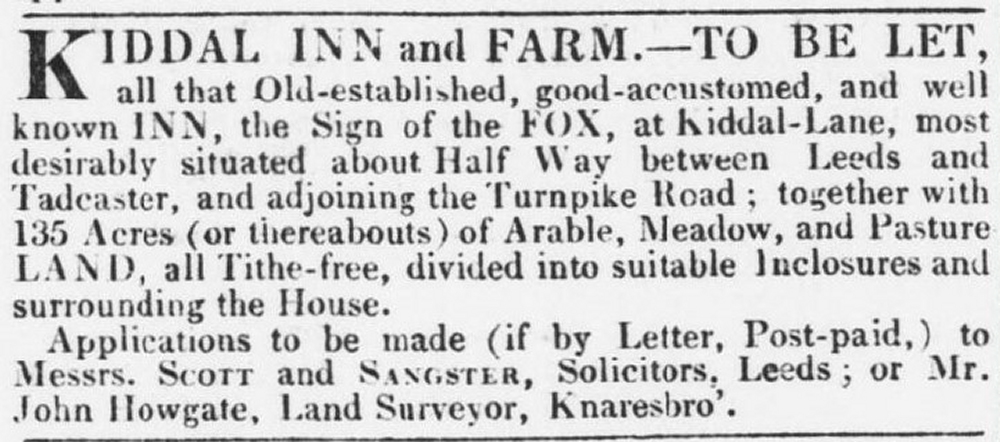 Leeds Intelligencer 30th September 1830. By 1831 Benjamin Dawson and his wife Mary took on the Inn and Farm and stayed for over 10 years bringing up a large family on the premises. In the early 1840s he moved to run a farm and inn in nearby Aberford. The 1830s and 1840s saw the start of an explosion in the construction of railways in the UK with lines starting to connect major cities. Trade on many turnpike roads suffered as traffic diverted on the much quicker and cheaper means of transport. When a railway linked Leeds and York in 1839 I am sure that many local roadside businesses suffered a massive loss of trade. Whilst we have no available accounts for the Fox and Grapes the nearby Old Red Lion Inn at Whinmoor, on the same turnpike road between Leeds and York was sold for £800 in 1835 but just 14 years later in 1849 trade had dropped off so much it sold for just £560. The owner of the Inn and Farm, Edward Wilkinson, of Potterton Hall, died on the 16th July 1836 and his estate became wrapped up in a family trust under the conditions of his Will. 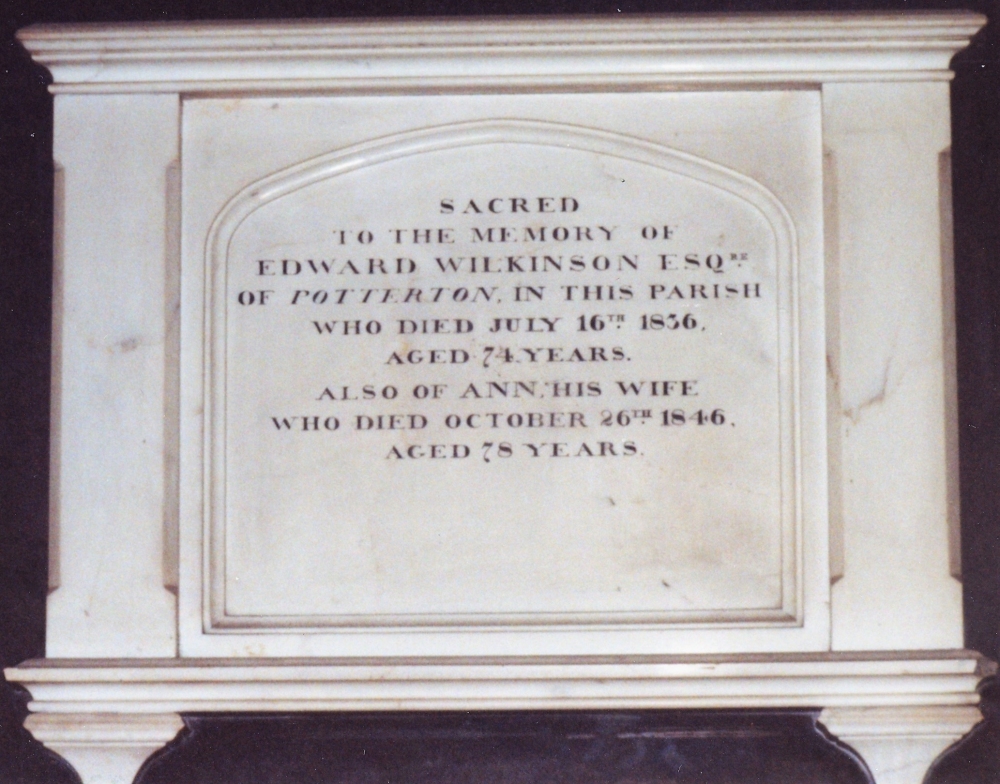 Memorial Stone for Edward Wilkinson in Barwick-in-Elmet, All Saints Church, owner of the Inn in 1836. Joseph Banks and his family ran the Inn for a short period in the 1840s but he sold up in 1847. It is likely that John Swale and his wife Ann with their large family moved in, there were certainly there by 1851 and the farm had expanded to 212 acres. On Boxing Day 1847 a man was found near the Inn in a starved condition, asked his name he replied in a very faint voice "Jack Dowler" and almost immediately died. At an inquest held at the Fox and Grapes by the Barwick in Elmet Overseers of the Poor and Mr. Jewison, the coroner, they thought he had been begging through the country and sixpence was found in his pocket. He was of light complexion and hair and there were no marks of violence on the body. The coroner ruled his verdict was "Died from want of sufficient nourishment". The Barwick All Saints Parish Register records he was buried in the churchyard on the 29th December, an unknown traveller. John Swale left in the summer of 1866 and William Cass from Healaugh, Tadcaster took a lease on the farm and inn. He stayed for 17 years until 1883 and the Inn was advertised to be let in the Yorkshire Post on the 11th December 1883: INN, Kiddal Lane, with 162 acres, is 3 miles from Leeds on The Leeds and York high road, and within 3 miles of Scholes Station on the North-Eastern Railway. - Apply to owner, B. E. Wilkinson, Potteron, Barwick-in-Elmet. William Hollings and his wife Martha Ann had taken over by 1887 and he applied in September 1893 for a 7 day licence which would enable the inn to open on a Sunday. A Skyrack Division Brewster Court sat in Leeds Town Hall to hear the application. Giving evidence Mr. Hollings said that he had frequently received requests from cyclists for milk and tea on Sundays, but was unable to supply them, only the previous Sunday he had had 17 requests from cyclists. Questioned he was asked "Cyclists don't take a lot of anything stronger, I believe.", there was laughter in the Court. He replied, "They seldom ask from anything but milk and tea, and I take a pride in supplying anything the public ask for." There was no opposition to the application and Mr. B.E. Wilkinson, the owner of the house was an ex-chairman on the licensing Court but it was stated he left the matter entirely in the hands of the Bench. Another witness supported the application and the Bench indicated that granting the licence would be a convenience to a large number of people. The Magistrates retired in private and returned to state they had decided to refuse the grant the licence! Martha Ann Hollings died in 1898 and William Hollings retired allowing his son Robert to take over the farm and Inn in January 1899. On the 26th January 1900 the retired 64 years William had been left in charge of the Inn whilst Robert worked on the farm. Into the front room of the Inn walked Jesse Cullingworth, a farm labourer, of Barwick. He was obviously well known and William refused to serve him as he was such a bad character. He managed to get him out of the house be he later entered again by the kitchen where he kicked up a row. The servants got William and he tried to eject him from the house but he was struck in face and attacked. He fetched Robert his son to help but Jesse refused to leave. Someone went to get Police Constable Dove. Henry Arnold was also hit when he tried to pull Jesse off Mr. Hollings. At the West Riding Petty Session Court Jesse was fined 40 shilling with costs or 1 month in jail.  1901 Census - Fox & Grapes, includes a man living in the barn. Landlord Robert Hollings gave up the Inn and farm in May 1901, becoming a commission agent for the sale of whisky and bar related equipment. The lease and licence was taken on by Charles Hill who came from the Black Bull Inn in South Milford. Ownership also transferred around this time within the Wilkinson family trust. On the 3rd March 1903 at the Barwick and Scholes Manorial Court the Inn and much other land was transferred to Mr. Bathurst George Wilkinson, Clerk in Holy Orders, formerly of Lennoxville, Quebec, Canada but then of Guilford, Surrey. Charles Hill and a number of locals were fined in February 1905 for opening and drinking at the Inn during prohibited hours, they were all caught by Police Sergeant Till at 10:20pm on the 21st January. It was stated in Court that Charles Hill was giving up the Inn and he subsequently left in May 1905. A clearer picture of the reasons why he left appears 3 years later in April 1908 when Charles Hill, now of Becca Home Farm, Aberford was declared bankrupt. In Court he stated that he was formerly of the Fox and Grapes Inn, Kiddal Lane, Barwick-in-Elmet, as a farmer and Innkeeper. He had paid an ingoing valuation of £410 to take over the premises, which he had borrowed. His trading there was very disastrous and when he left he was owing £2,000. He received an outgoing valuation of £365. His wife had managed the Inn during the day and him at night. He believed the Inn had been badly managed, a great deal more drink was consumed that was paid for. He heard that the wrong change was regularly given, as much as 9s 6d being given as change for a sixpence! He explained that during the 3 years he had been Becca Farm he had reduced his debt by £1,000 but the deficiency was £714 9s 10d. By 1911 Charles and his wife Sarah Ann were living at Ackworth near Pontefract and he was working as a cowman on a farm. Barwick born John Albert Perkin took over in May 1905, he had married Agnes Richardson at Barwick All Saints Church in October 1898 and they had 4 children, sadly a boy named William died in 1906 aged 5. For the quiet country folk of the district their time at the Inn can be described as no less than a sensation. I am sure that long before the local newspaper published the headline in January 1909 "A BARWICK DIVORCE CASE - FARMER'S ALLEGATIONS AGAINST HIS WIFE - A WALK AFTER CHURCH" the locals had heard the story. Divorce in Edwardian England was very rare and only available to men in cases of adultery by his wife. The proceeding were in open court and freely reported by the press of the day. In the Divorce Court it was explained that John had taken on the Inn and Farm of 200 acres in 1905. A year after they arrived their son William had died and his wife had given way to drink. He had deprived her of the keys to the bar and the place where the spirits were kept but she appeared to have obtained a duplicate set. When she had been drinking "she lost all womanly control and womanly feeling". On an overcast Sunday night, the 5th April 1908 she went to Barwick All Saints Church for the service and to put flowers on the grave of her son. There she met a Groom called McGrath, who also occasionally drank at the Fox and Grapes. After the service was finished she was seen "under very suspicious circumstances" by two young men. John Speight said he worked at Park House Farm in Kiddal and on that evening he witnessed "misconduct" between Mrs. Perkin and McGrath close to a gate near the Fox and Grapes. Violet Jacques, who formerly worked at the Fox and Grapes for Mr. Perkin said he saw McGrath with his arm around Mrs. Perkin in Bar Lane at about 9:00pm. Mr. Perkin said his wife did not come home until 10:00pm, "flushed and looked as if she was thinking about something". Eliza Simpson said she went to All Saints on that Sunday night and did see Mrs. Perkin on the way to Church but not inside. She saw McGrath with his arm around her. Under the instruction of her husband Mrs. Perkin was questioned about the incident on the 7th April in the presence of the two young men who had witnessed it. Instead of denying it, she turned to one of the young men, and said "I didn't see you there." The jury found her guilty of "misconduct" and the Judge granted a decree nisi with custody of the children to the father John A. Perkin. 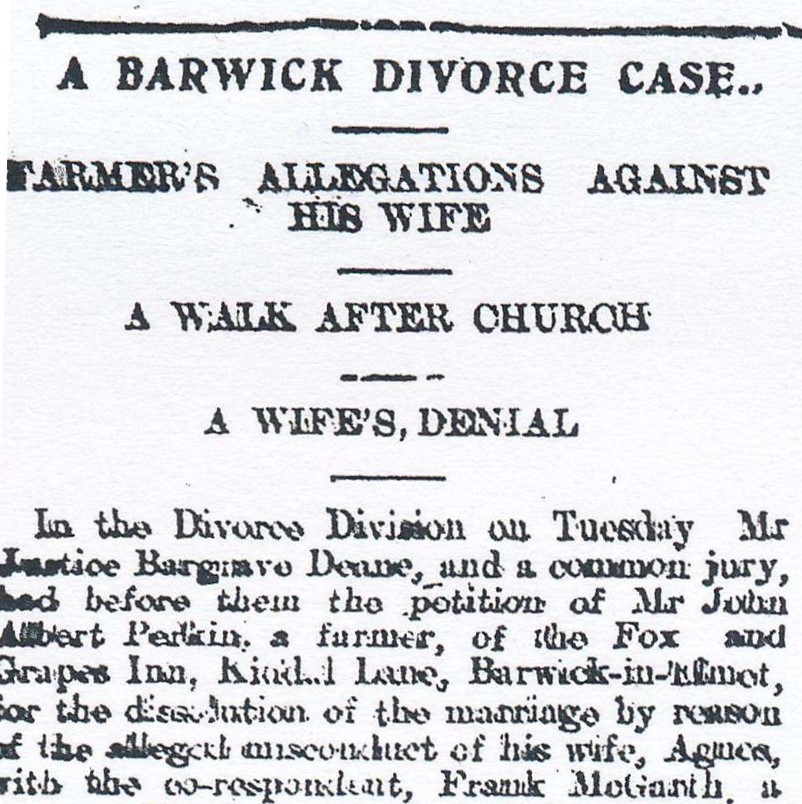 Skyrack Newspaper - 22nd January 1909. In the 1911 census John is listed at the Inn, as a single man, with his 3 children, 3 servants and his sister Annie Perkin as housekeeper. There is a twist to this story, Agnes died in 1926 aged 54 and she was buried in All Saints, Barwick Churchyard in the same grave as her little boy William. When John Albert died 14 years later in 1940 he was also buried in the same spot and the memorial marked "Husband". No re-marriage can be found and I have been unable to discover if they lived together but perhaps a sort of reconciliation took place. Around 1909 the property was valued and described as; Tap Room, Bar, Dining Room, Spirit Room & Cellar; all licenced. Unlicenced Sitting Room, Kitchen, Scullery, Pantry Cellar + 7 Bedrooms. Buildings: Old Brewhouse used as meal house, Coal Room & Store Room. Lean to Stable for 3. Turnip house (lean to) 2 loose boxes + stable for 4 + 3 (loft over). 3 Pig Cotes, Mistal for 8, Shed or Fold Barn. Mistal for 2 + Fodder Room, Mistal for 6. Box & 2 Sheds on Fold. All buildings stone built & in fair repair. Trade: Takings £6 per week average, about 36 gallon per week, 2 gallon spirits, 3 dozen bottles per week. John Albert gave up the Inn in April 1912 and Richard West took over. In 1917 Bathurst G. Wilkinson decided to sell all his Potterton Estate which included Potterton Hall, Kiddal Hall, Woodhouse Farm, The Fox & Grapes Inn and Farm, Kiddal Lane Farm, Bar House Farm, Brick Pond Farm, Potterton Grange Farm, Blacksmith shop and house and Toll Bar House, in total 1,222 acres. An auction was arranged on Tuesday, 30th October 1917 3pm at the Leeds Law Institute, Albion-place, Leeds. Lot 4 was: (partially Freehold and partially Copyhold of the Manor of Barwick-with-Scholes) This Lot comprises: The Fully Licensed (6 days' Licence) Fox & Grapes Inn containing Sitting Room, Dining Room, Snug, Filling Bar, Tap Room, Kitchen, Scullery, Wash-house and Dairy. There are seven Bedrooms, and Spirit Room, and in the Basement are Beer Cellar and Milk Cellar. The Farm Buildings comprising Mixing Place, three-stall with Chamber over, Loose Box and Stable for four horses with Granary over, Trap Shed, Piggeries, Mistal for seven cows, Barn, Cattle Shed and Yard, Small Mistal, Trap House, Mistal for six beasts, two Loose Boxes, Cart Shed, and Hen House, and 174 acres 2 roods 25 perches. Let to Mr. Craven Gilpin on a yearly tenancy at the rent of £170 per annum.  1917 Auction Catalogue. It is believed the bidding reached £3,900 which was lower than the reserve set and the lot was withdrawn. It was subsequently advertised in November 1917 with 50.5 acres for sale by private treaty. In the end Kiddal Hall and Farm, the Fox and Grapes Inn and Farm, Woodhouse Farm, Brick Pond Farm and Kiddal Wood, in total containing 741 acres and 14 ¼ perches was sold to Charles Foster Ryder of Scarcroft Grange. He was a director of large Leeds based brewery Joshua Tetley and Son Ltd. Interestingly his youngest daughter Sue Ryder founded the Charity which bears her name and runs the Wheatfields Hospice in Leeds. Craven Gilpin the lessee was the founder of Gilpins outside caterers based at the Mansion in Roundhay Park and there is no record of him running the Inn which he must had sub-let. Whilst there are limited source records I have found Gilpins mentioned as lessees or involved with house in 1917, in the 1960s, 1973 and 1977 and in January 1984 a dormant company called "Gilpin (Fox & Grapes) Limited of Leeds" was voluntarily wound up. 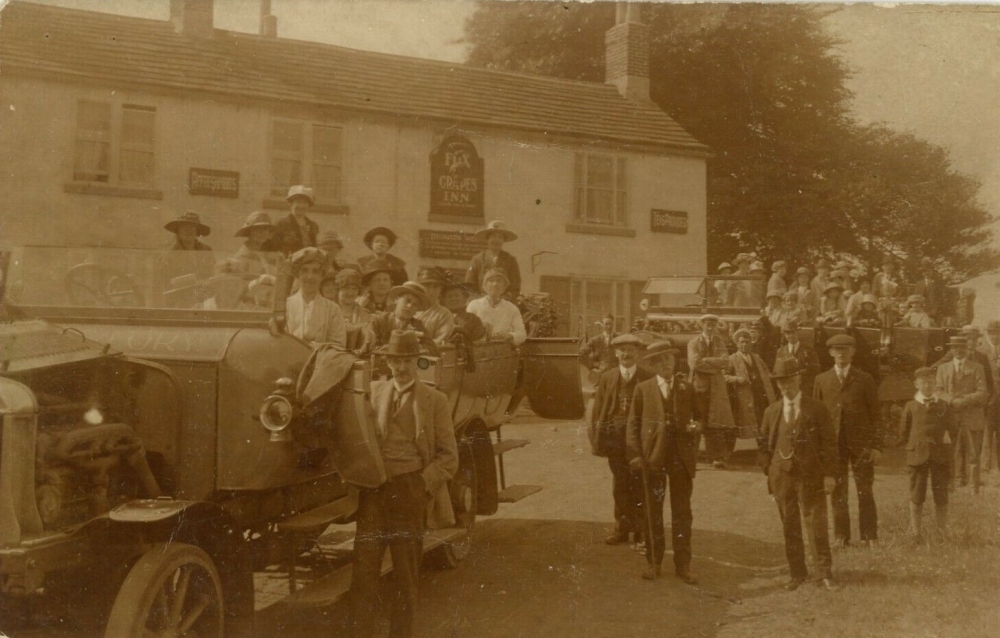 A charabanc trip visits the Inn about 1920 when Richard West was landlord. Richard West was landlord during the First World War and died in June 1924 aged 57. Mrs. West his widow sold up the farm stock the following month and in July William Brown took over, he stayed until March 1929 and then Fred Driffield took on the Inn and Farm. In February 1933 the Skyrack Licensing Court held in Leeds decided not to renew the alcohol licence for the Fox and Grapes as the "premises were structurally deficient", they agreed to defer the final decision for 1 month. At the subsequent Court sitting in March Mr. Curtis appeared on behalf of the owner Mr. Ryder JP of Scarcroft. He explained that the house was on an agricultural tenancy with a yearly rental of £220 and the cost of updating the house would be in the region of £2,600. The house was used by transport drivers as a regular calling house for sandwiches, teas and coffee. It was the only house between Seacroft and Tadcaster. The present lease was to expire in April 1934. Ex Police Sergeant Betts said he was stationed at Scholes for the last 7 years and the house had a 6-day licence. The building and accommodation were in a bad state of repair. Attached to the house was 106 acres of grass land and farm buildings. The house did very little catering. Never in his 36 years experience had he seen a house in such a bad condition. He said "the public would not suffer or be inconvenienced in any whatever if the licence was taken away. The approach was terrible in bad weather." Fred Driffield, the licensee said he was a farmer not a licensed victualler. He said it was a good house in summer but did nothing in winter. He could dispose of upwards of 50lbs of beef in summer, ham, pork pies and cheese were also freely sold. The beer trade was good in the summer but prices had killed everything. He agreed the house was in bad repair but could not afford to pay £20 or £25 a year more rent should be the house be updated. Mr. Curtis said the owner Mr. Ryder was in a nursing home and it made the case difficult for him but requested the licence be renewed for a year. The Clerk to the Court said that a promise was given 12 months ago that something would be done. Superintendent Dance said, "the contention of the police is that the place is only a farmhouse, and can only be used as such." The Bench said the next house was a long way off but unless undertakings were given to carry out improvements the licence would be removed and referred for compensation (a process to close public houses). A one-month extension would be given only. The following month Mr. Curtis came back to the Court with plans to update the Inn and an undertaking to complete the works by July 1st. The Court approved the annual licence and hoped that Mr. Driffield, the landlord would take note of what was being spent on the inn, and that people would be properly accommodated when they called. Tadcaster Rural District Council reviewed the alteration plans during early April 1933 and these included the removal of external earth closets and the construction of new ladies and gentleman's toilets attached to the south-west corner of the Inn. The public area of the inn at the time included a large entrance hall, a tearoom, smoke room and public bar. The Inn had no mains water at this time and relied on two wells. One was in the floor of the kitchen and was 26 feet deep and had 11 feet of water, another outside at the front of the inn by the stable and calves block was 49 feet deep and had 27 feet of water. On the external well the District Surveyor reported "the covering over the top of the well consists of loose flags and semi-decayed timber and is certainly far from the ideal of what the supply to a Public Inn should be. It is obvious that is there was a rainstorm there is nothing to prevent filth of any description from being washed into the well." He recommended that the Inn be connected to the Barwick water main which just at that time was having 3" cast iron pipe laid to Potterton Hall. This suggestion obviously appeared to be too expensive as the wells were relined and improved and a pump installed to fill a cast iron water tank above the new toilet block. The Council approved the plans on the 10th April and builder, Mr E. Burnett, of Paddock Cottage, Thorner, commenced work on the alteration on the 1st May 1933. 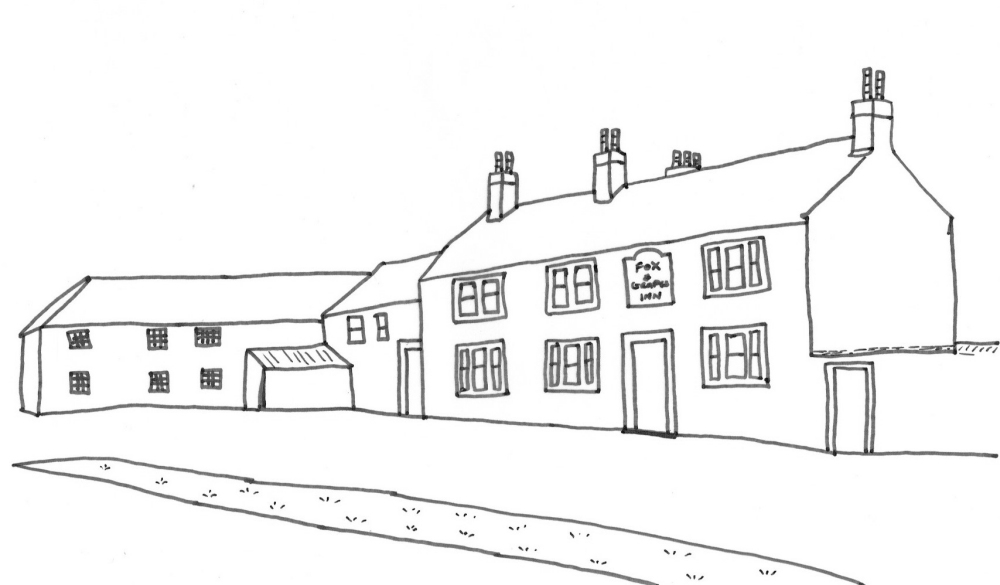
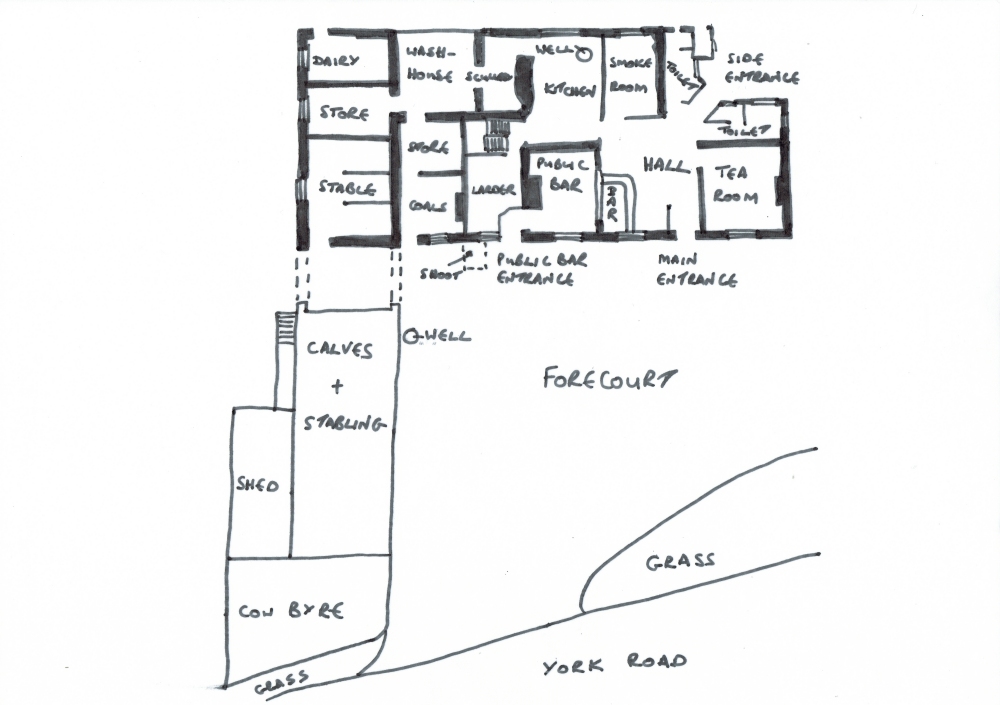 Fox & Grapes, circa 1935. Fred Driffield left in early 1936 and Mr. Ryder then applied for a 7-day licence which was finally granted on the 4th February. Joe Fenton took on the licence in August 1936. On the 18th August 1937 Mr. Ryder sold the inn to Joshua Tetley and Son Ltd, the Leeds based brewery which had a large tied-house estate and the Company he was a director of. The 1937 sale only included the inn, the adjacent farm buildings, and land immediately around, just over 5 ½ acres. 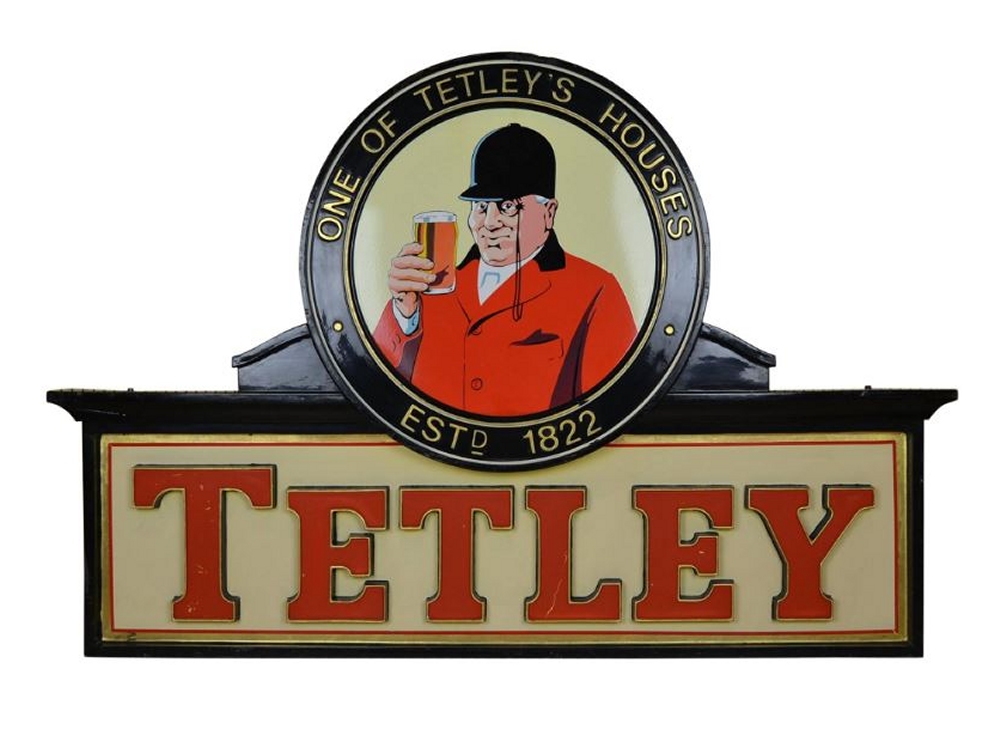 In 1939 husband and wife Joe and Ethel Fenton are listed as hotel manager and manageress with daughter Marjorie helping as a barmaid and a live-in domestic servant Iris Stone. The Fenton's stayed at the inn all during the 2nd World War and he died in Blackpool in February 1946 aged 60 listed as of "The Fox and Grapes Hotel, Kiddal-lane, Barwick." Fred Cardus and his wife Olive took over but sadly they were there less than 2 years with Fred dying in February 1948 aged only 50. Gerald Oddy then took over with his wife Jennie having come from the Red Lion Hotel in Bramham. Major alterations were made in 1955 internally and the old stable block was demolished. 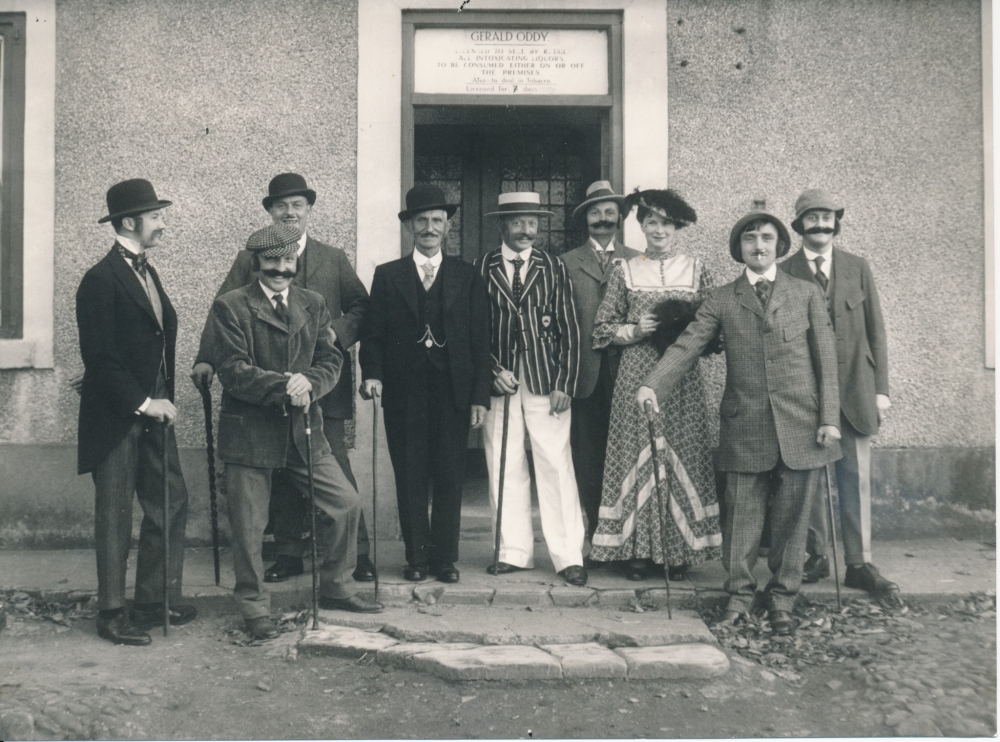 Landlord Gerald Oddy (in stripped clothes) at a fancy dress event in the 1960s. A go-carting track was built at the rear on the house in the 1960s no doubt relating to the Oddy's son Tony who was a rally driver. There are reports of large crowds at carting events held at the weekends. 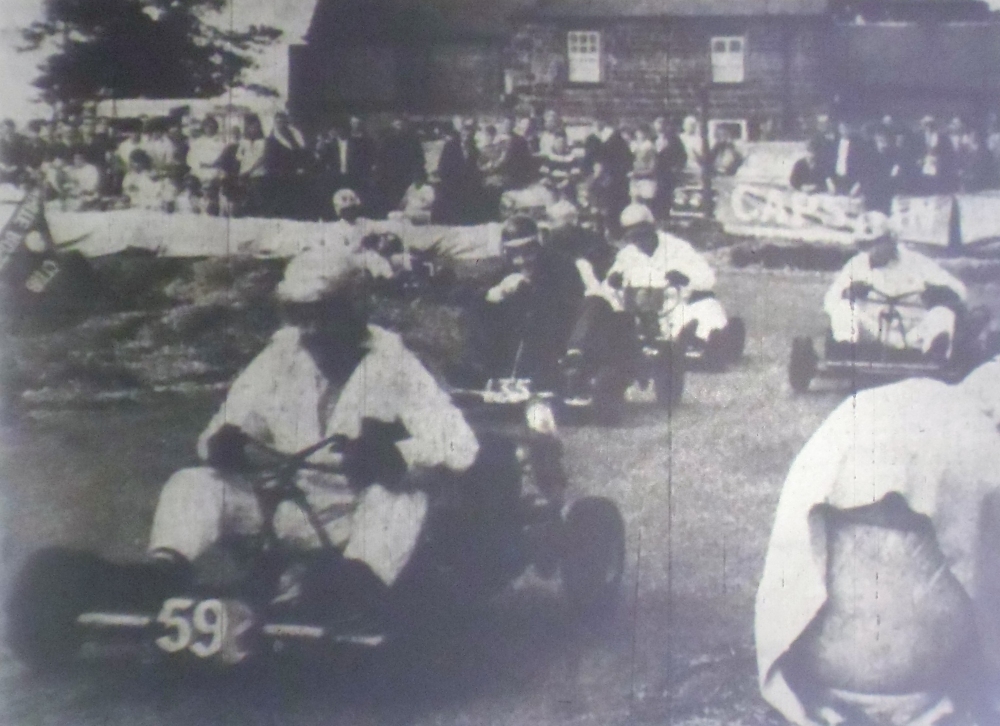 Go-carting event at the rear of the Inn in August 1963. In 1965 the rock band "The Rollings Stones" dined at the Fox and Grapes whilst on tour and travelling between venues. After eating and signing autographs they left and accidently left some items behind. Tony Oddy, the landlord's son, chased after their Jaguar car in his Mini Cooper catching them up at the Woodpecker lights on the outskirts of Leeds and handing the items over. 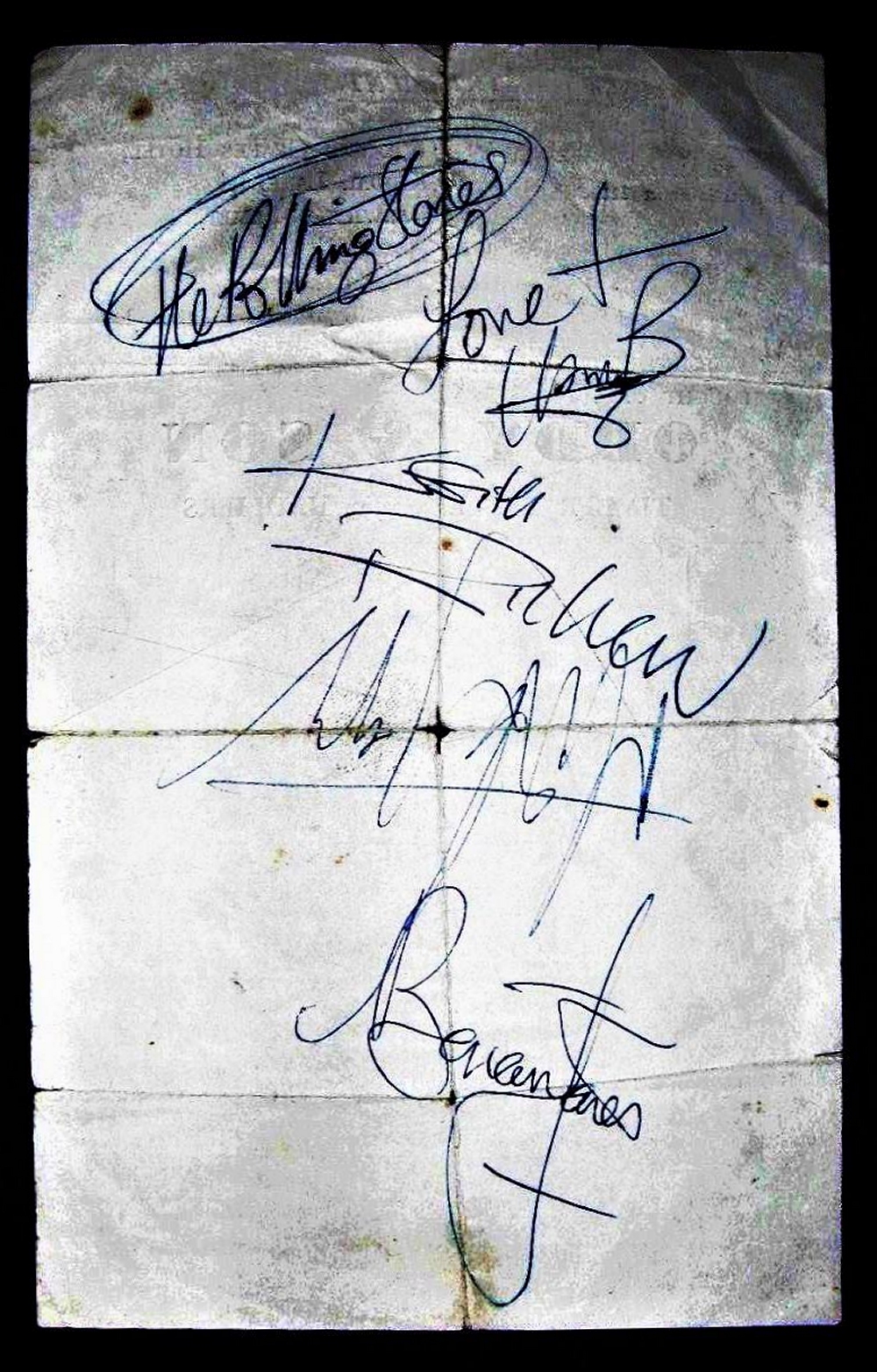 Autographs of The Rollings Stones taken at the Inn in 1965. Further alterations took place in 1969 when new garages were built and in 1973 an extension was constructed. The interior was described in the 1960s as; The John Gilpin bar and dining room which was originally the old beer cellar sears 26 to capacity and caters for small parties. Beams, (some original), stone walls with candle type lighting in wall alcoves, and several coach lamps, create a cosy intimate atmosphere for dining. The Fox and Grapes has a large passing trade as well as local, and a large car park can adequately take the amount of vehicles. Lunch is from 12 noon to 2.15 p.m. and dinner from 6 p.m. to 9.15p.m. Monday to Friday, with steak and fish a speciality. A cold buffet table is provided during the weekend and bar meals include sandwiches and Cornish pasty. Red and white wine can be bought by the glass and wine for the table is sold at cost price to diners. The inn provides facilities for children by having coloured tables and chairs outside on the terrace. Tetleys; Double Diamond; Skol Lager.  The Inn in 1967. © Skyviews. Gerald Oddy left in 1974 after been at the inn for 26 years. Many landlords and staff have worked at the house over the subsequent years. Ownership of the house had passed from Joshua Tetley & Sons Ltd to Allied Breweries (UK) Ltd of Burton-on-Trent in the 1960s due to brewery mergers. This Company became Allied Lyons is 1978. 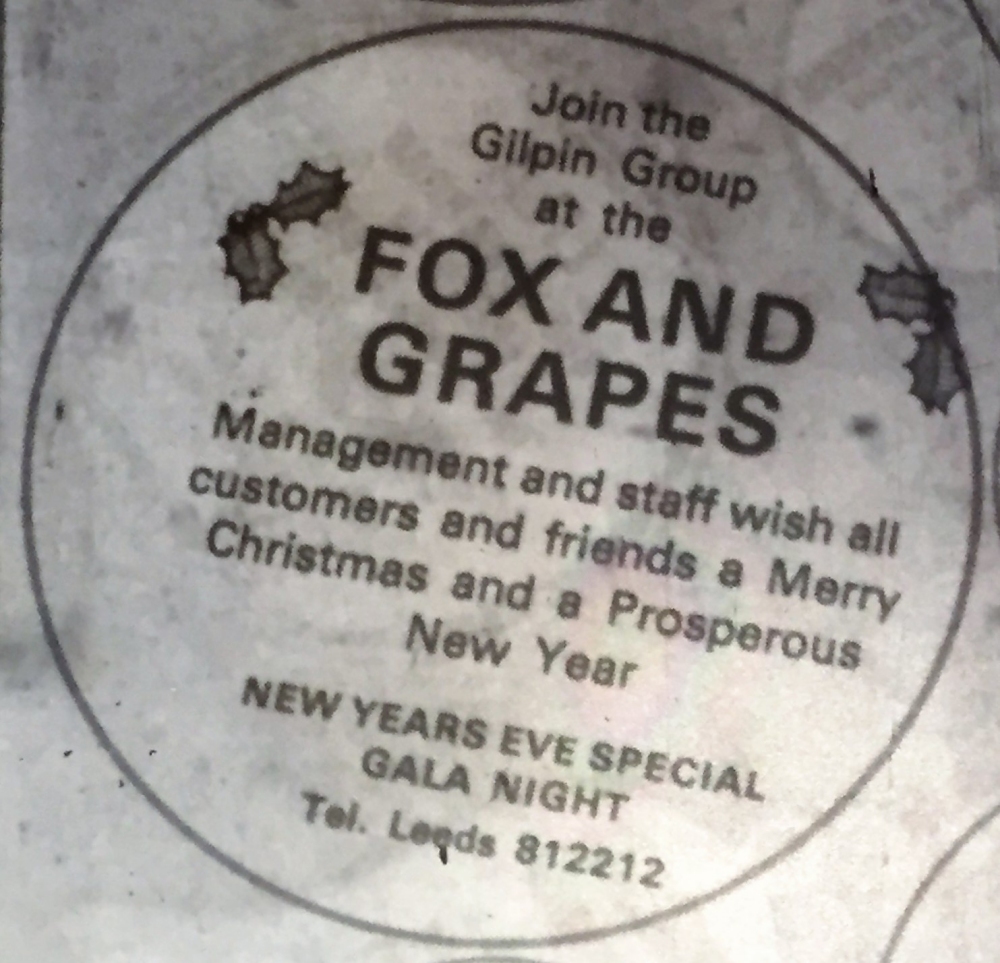 Christmas 1977. By the 1980s brewing and pubs in the UK had come to be dominated by giant companies known collectively as "The Big Six" which including Allied Lyons. Starting in 1989 the Government, on recommendations from the Monopolies and Mergers Commission, decided to cut the breweries hold over public houses and they were forced to start to sell their estates. The Fox & Grapes has passed through a number of hands since this time and, as of May 2022, is owned by the Stonegate Pub Company Ltd of Solihull. Today it still provides food and refreshments to travellers, locals and visitors as it has done for probably well over 380 years. 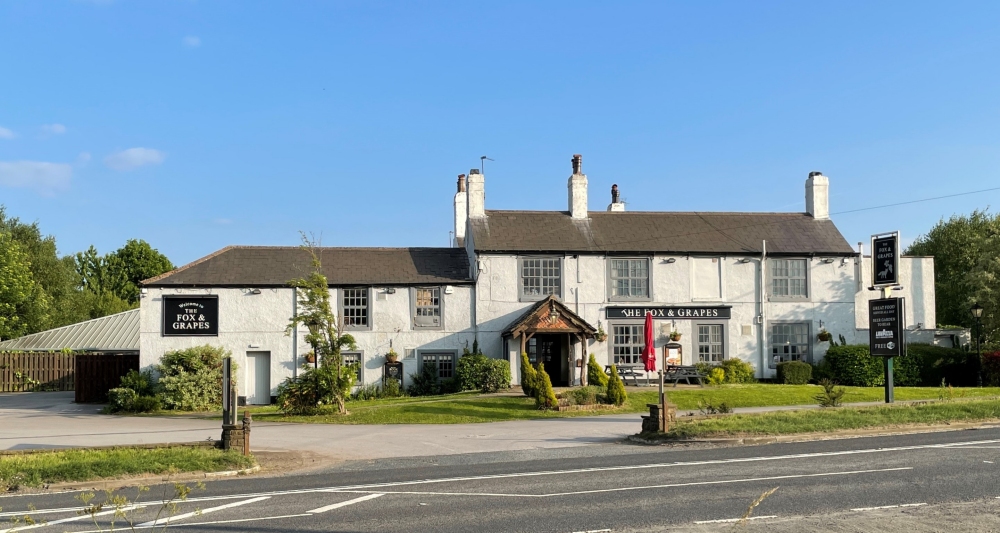 Fox & Grapes 2022. Appendix - Known history of the site before 1793 (BRM - Barwick and Scholes Manorial Records - West Yorkshire Archives, Leeds) 25th June 1793 - Sold by Sir Henry Goodrick, late of the City of York but then of Ribston, Yorkshire to Edward Wilkinson, Esquire of Potterton Lodge, Barwick. (BMR 211 Page 283) August-October 1791 - Legal procedure to break the entail on the land under the Will of Robert Lord Bingley, late of Bramham Park to enable his great grandson Sir Henry Goodricke to inherit and sell the land. (BMR 211 Pages 225-237) 11th January 1776 - Robert Lord Bingley who was long since dead in his Will had passed the land to his daughter Harriet Benson who married George Fox, she had died without issue so the land passed by his Will to Mary Goodricke husband of Sir John Goodricke, his other and natural (illegitimate) daughter, for her life and then to male heirs. (BMR 210 Page 254) April 1771 - Harriet Fox (nee Benson), wife of George Fox and daughter of Robert Lord Benson died. 10th October 1733 - Robert Lord Bingley had died and the land passed to his daughter and heir, Harriet Fox who was the wife of George Fox. (BMR M1/26 Skin 2) 9th April 1731 - Robert Lord Bingley died and in buried in Westminster Abbey, London. 24th September 1722 - Robert Lord Bingley surrendered his land to the use of Will. (BMR M1/23 Skin 2) 9th February 1720 - Margaret Lowther, a widow of Swillington, William Ellis and his wife Mary of Rowall, Yorkshire sell the land to Robert Lord Bingley. (BMR M1/22 Skin 12) 15th November 1703 - William Ellis of Rowell, Yorkshire (likely in the Parish of Kellington) mortgaged the land to Margaret Lowther of Swillington for £550 (BMR M1/20 Skin 16) Prior to this date the land likely descended through the Ellis family who lived and owned the adjacent Kiddal Hall from at least the 1390s. © Dave Teal June 2022 Main Sources: West Yorkshire Archives Service - Leeds - Barwick and Scholes Manorial Records in collections WYL115 & WLY382/acc1578 (BMR) - Gascoigne Papers and Estate Surveys West Yorkshire Archives Service - Wakefield - Skyrack Licencing Registers - West Riding of Yorkshire Registry of Deeds Leeds Central Library - Maps, Electoral Registers, Local Directories & Telephone Directories British Library Newspapers - Boston Spa - Roundhay Gazette, Skyrack Courier, Boston Spa News, Leeds Intelligencer, Leeds Mercury, Leeds Times & Yorkshire Evening Post - Barwick-in- Elmet Historical Society Archives Back to the top Back to the Main Historical Society page Back to the Barwicker Contents page |
